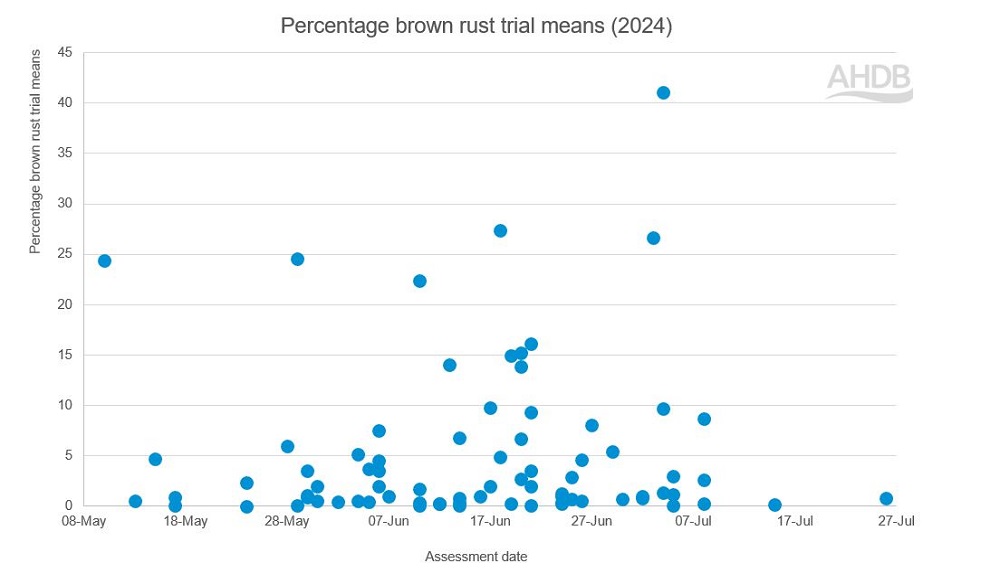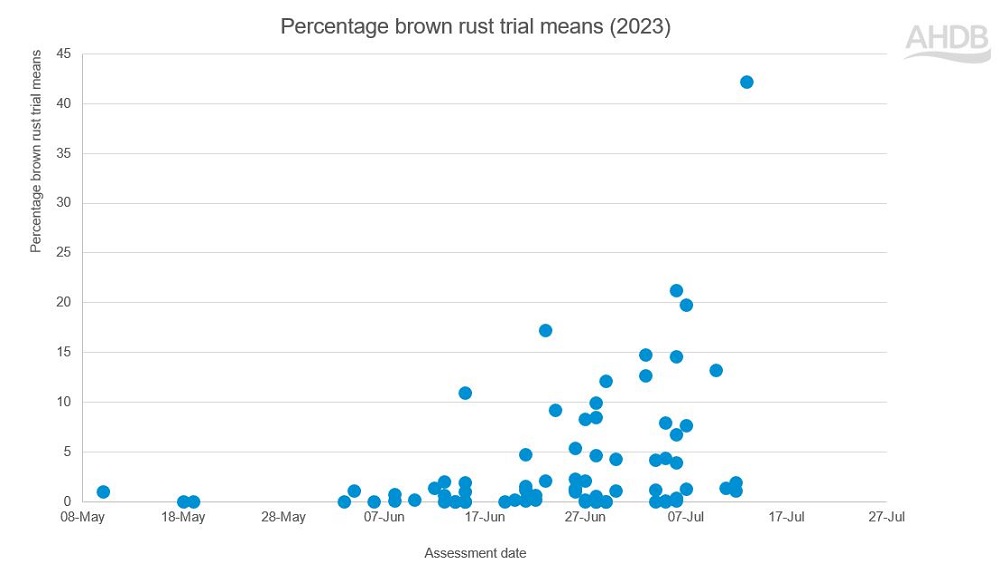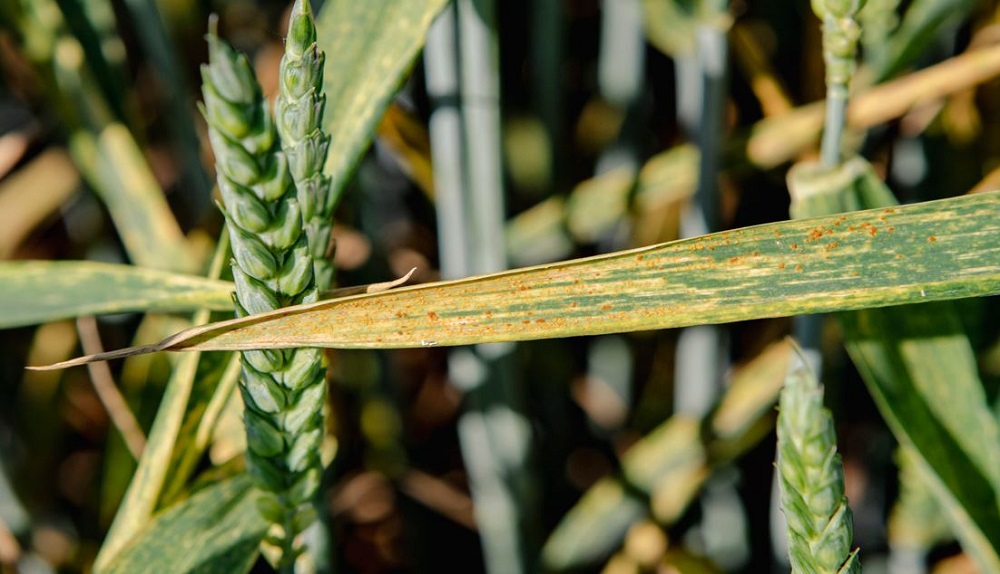Disease delivers a tough test for varieties in RL winter wheat trials
Wednesday, 18 September 2024
Even belt-and-braces fungicide programmes often failed to keep foliar diseases of winter wheat in check during the 2023/24 growing season. AHDB Senior Crop Protection Scientist Catherine Harries examines disease data from the Recommended Lists (RL) trials.
Most RL trials aim to limit the influence of factors that may hold back genetic potential. For example, we aim to keep disease as low as possible in fungicide-treated trials.
The high disease pressures across the UK meant that we struggled to keep a lid on disease this year, just as many farmers did in their commercial crops.
When chemistry struggles to keep up, varietal resistance is called upon to do more heavy lifting. Certainly, RL harvest results winter wheat data reveals the increased importance of genetics in the 2024 crop.
In 2024, the winter wheat varieties with the highest yields are those with good disease ratings, even in the fungicide-treated trial series.
Until recently, we aimed to keep disease below 5% in fungicide-treated trials. If disease was above this, the yield information would not have been used in the main data set. With the chemistry now available, we can no longer hope to keep disease below 5%, especially in a high-disease-pressure year, such as 2024.
With the potential to lose large amounts of data, we now include data from fungicide-treated yield trials even when disease exceeds 10% (if the fungicide protocol has been followed). The revised RL protocols now better assess genetic potential in context with the fungicides available to us today.
Brown rust
In 2024, we saw high levels of brown rust. What was particularly unusual was how early we saw it. This can be illustrated in charts that compare disease observations in 2024 with a more typical year (such as 2023).
Brown rust observations in 2024 (early)
 AHDB
AHDB
Brown rust observations in 2023 (more typical)
 AHDB
AHDB
We are processing disease data for inclusion in the next edition of the RL, which is due online on 2 December 2024.
Early indications show that the disease pressures in 2024 are unlikely to translate into major changes in the relative order of disease resistance.
There was some evidence of a little more and a little less disease in some varieties compared to 2023. As usual, some minor adjustments to brown rust disease resistance ratings should be anticipated in the next RL.
Early next year, we will update the brown rust watch list too.
The rust watch lists provide a way to flag unusual levels of specific diseases observed in some trials, compared with what the headline disease rating would otherwise suggest.
This extra layer of information may provide a valuable early warning of a potential change in the UK’s race structure and help focus in-season management strategies.
The AHDB-funded UK Cereal Pathogen Virulence Survey (UKCPVS) also helps us monitor changes to the brown rust pathogen population.
In the last few years, it has provided good data on the nature of the pathogen isolates associated with increased brown rust levels on Theodore.
Yellow rust
The pathogen that causes yellow rust is diverse, with many isolates in the UK population. Numerous isolates only infect certain varieties.
To add further complexity, some winter wheat varieties are susceptible to yellow rust when plants are young but develop some level of resistance after early stem extension (the adult-plant stage).
Since 2022, we have included information on young plant resistance to yellow rust in the RL publication.
To date, young plant resistance has been categorised in growth rooms using five pathogen isolates selected by UKCPVS.
As the isolates chosen for the tests are a subset of a diverse population, actual field performance may differ.
Despite this, a recent review of UKCPVS showed farmers and agronomists find young plant resistance information useful.
This year, we piloted a new way to provide robust data in a cost-effective way.
The pilot measured yellow rust in winter wheat field trials, with crops infected by the isolates naturally present.
We conducted three trials: two in Cambridgeshire (one was also inoculated) and one in Midlothian.
The twist to the approach was that the trials were drilled in mid-May, so varieties were still at the young plant stage in June, when yellow rust usually peaks.
Overall, the trials gave good levels of yellow rust and differentiation between varieties.
The results also correlated relatively well with the traditional UKCPVS growth room tests.
KWS Skateum (a candidate in harvest 2023 trials) was an exception, which was resistant in growth room tests in 2023 but not in all the field trials. This result reflects the diverse populations present in the field.
The pilot successfully provided a more real-world appraisal of resistance at the young plant stage, with potential to supplement UKCPVS data.
In 2024, UKCPVS is testing more isolates than usual in the growth room tests to better reflect pathogen diversity. This will provide data for next edition of the RL.
To date, the screens have used 13 isolates, with the results broadly aligning with the 2023 growth room tests (although there are some exceptions).
UKCPVS growth room screening results and young plant field data are available to download.
Yellow rust young plant data from growth room and field experiments (2024)
Compared with 2023, we observed higher levels of yellow rust on some varieties in 2024 trials. Once again, we expect some minor revisions to disease ratings in the next RL.
Early next year, we will also update the yellow rust watch list to flag potential changes to the population.
UKCPVS next phase
The next phase of the UKCPVS (2025–2027) is about to get underway.
Its original objective was to monitor changes in the ability of foliar pathogens to cause disease on cereals.
The project will now focus on supporting breeding efforts to develop durable sources of resistance to wheat rusts.
It will also continue to provide information on the young plant resistance status to wheat yellow rust and manage strategically important pathogen isolate collections and differential variety sets.
Further details about the next phase will be published later this year.
Septoria leaf blotch
Finally, septoria leaf blotch has been a management challenge in RL trials and commercial crops in the last couple of seasons.
In the 2024 RL trials, the most septoria susceptible varieties – KWS Firefly (no longer listed) and Swallow (disease rating of 5.1) – had four times more septoria than the most resistant variety – Mayflower (disease rating of 8.9).
Despite the extremes, we do not anticipate major changes to disease ratings in the next RL edition.
Visit the Recommended Lists (RL) home page
In spring 2024 @ADASGroup @SRUC and @niabgroup tested a new way of getting information on the seedling (or young plant) susceptibility of winter wheat varieties to yellow rust for @AHDB_Cereals pic.twitter.com/jRYSbngRF2
— Catherine Harries (@CatherineHar4) September 23, 2024




